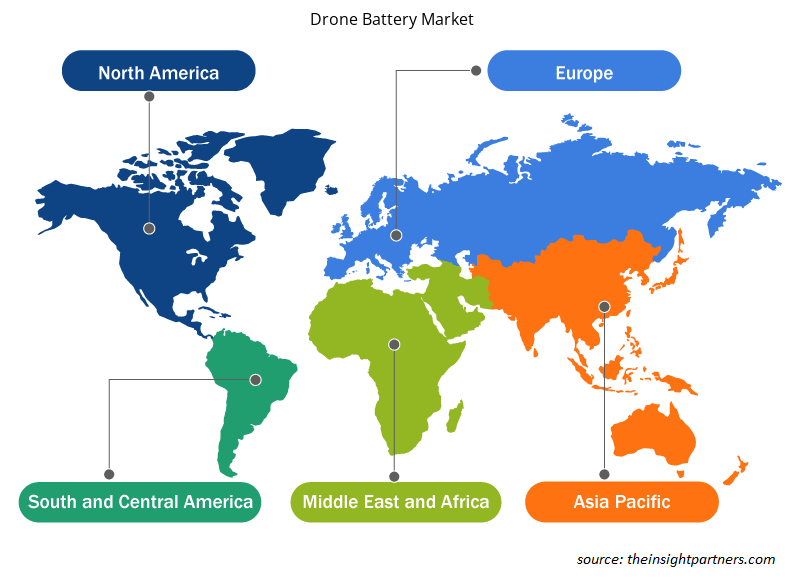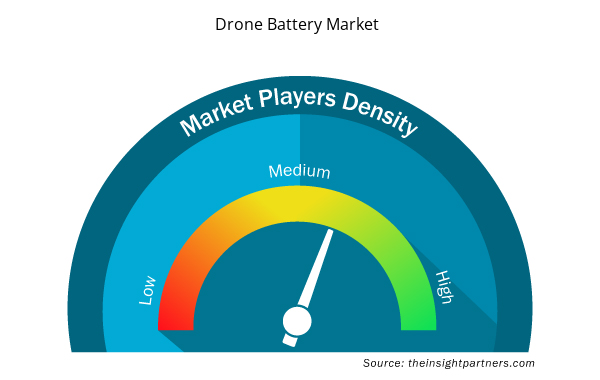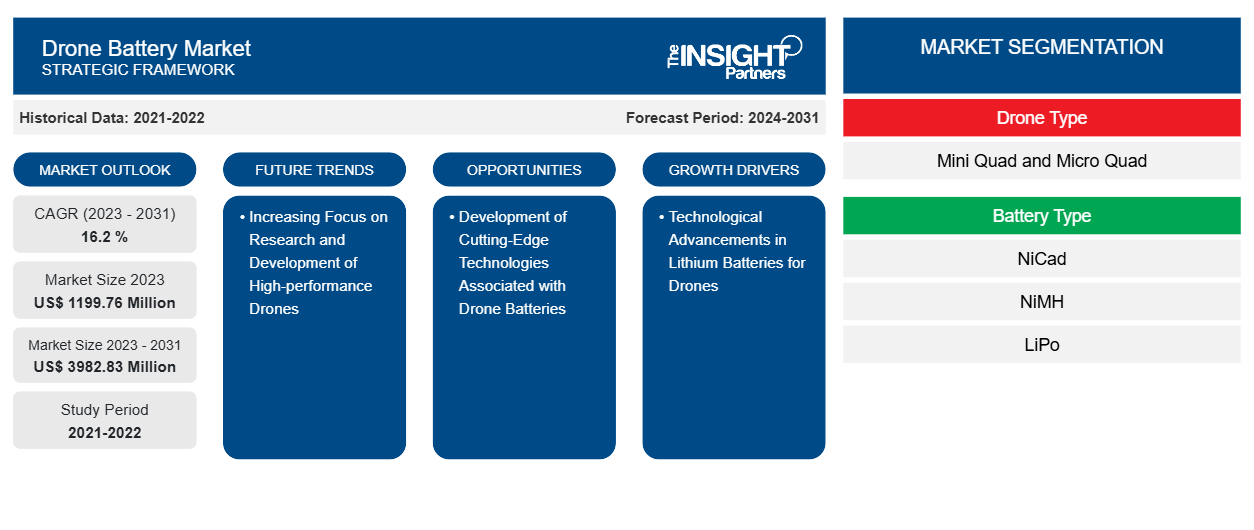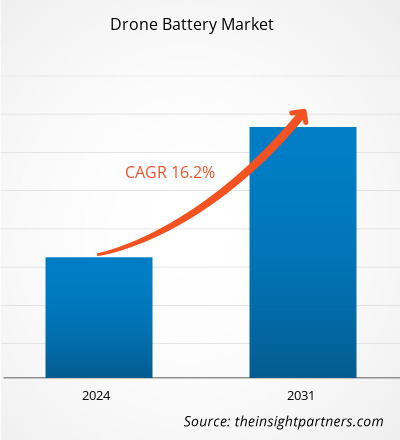Si prevede che la dimensione del mercato delle batterie per droni raggiungerà i 3982,83 milioni di dollari entro il 2031, rispetto ai 1199,76 milioni di dollari del 2023. Si prevede che il mercato registrerà un CAGR del 16,2% nel periodo 2023-2031. È probabile che la crescente attenzione alla ricerca e allo sviluppo di droni ad alte prestazioni rimanga una tendenza chiave nel mercato.CAGR of 16.2 % during 2023–2031. Increasing focus on research and development of high-performance drones is likely to remain a key trend in the market.
Analisi del mercato delle batterie per droni
Il mercato globale delle batterie per droni è guidato principalmente dalla crescente adozione di droni in una varietà di applicazioni come rilevamento, mappatura e monitoraggio. Inoltre, il crescente numero di start-up di droni sta guidando l'espansione del mercato delle batterie per droni a livello globale. Ad esempio, il numero totale di start-up di droni in India è aumentato del 34% tra agosto 2021 e febbraio 2022. Tali fattori stanno offrendo opportunità per il mercato delle batterie per droni in India.
Panoramica del mercato delle batterie per droni
Le batterie per droni sono batterie ricaricabili che possono essere utilizzate per i droni. Sono generalmente realizzate in polimeri di ioni di litio (Li-ion) o polimeri di litio (LiPo) e sono disponibili in varie dimensioni e capacità. Le batterie per droni sono necessarie per tempi di volo più lunghi e possono rappresentare un possibile rischio di incendio se non gestite correttamente. Il tipo di batterie utilizzate dal drone può essere un fattore importante per il funzionamento del drone, incluso il tempo necessario per la carica tra un utilizzo e l'altro e la velocità di scarica. Le batterie per droni più utilizzate sono quelle ai polimeri di litio (LiPo), al nichel-cadmio (NiCad) e agli ioni di litio (Li-ion).LiPo) and come in various sizes and capacities. Drone batteries are necessary for longer flight times, and they pose a possible fire hazard if not properly handled. The type of batteries your drone uses can be an important factor in how the drone functions, including the time it takes to charge between uses and the rate of discharge. The most widely used drone batteries are Lithium Polymer (LiPo), Nickel Cadmium (NiCad), and
Personalizza questo report in base alle tue esigenze
Riceverai la personalizzazione gratuita di qualsiasi report, comprese parti di questo report, o analisi a livello nazionale, pacchetto dati Excel, oltre a usufruire di grandi offerte e sconti per start-up e università
- Scopri le principali tendenze di mercato in questo rapporto.Questo campione GRATUITO includerà analisi di dati che spaziano dalle tendenze di mercato alle stime e alle previsioni.
Driver e opportunità del mercato delle batterie per droni
Progressi tecnologici nelle batterie al litio per i droni
I droni hanno registrato una notevole crescita a livello globale negli ultimi anni. A causa dell'aumento della sicurezza delle frontiere e dell'intrusione nemica, diversi governi e aziende si concentrano sull'acquisto di UAV. Ad esempio, nel 2022, la Federal Aviation Administration (FAA) ha segnalato che negli Stati Uniti nel 2023 sono stati registrati 855.860 droni. Pertanto, con la crescente domanda di droni, si prevede che il mercato delle batterie continuerà a crescere in modo significativo durante il periodo di previsione. Inoltre, l'aumento delle associazioni di droni specifiche per paese come la Czech Unmanned Aerial Alliance di recente formazione, l'Association du drone de l'industrie française (ADIF) in Francia e numerose altre in Asia, tra cui la Korea Drone Industry Association, la Korea Drone Association, la Shenzhen UAV Industry Association e la Japan UAS Industrial Development Association sta anche integrando la crescita del mercato delle batterie per droni.UAVs. For instance, in 2022, the Federal Aviation Administration (FAA) reported that 855,860 drones were registered in the US in 2023. Therefore, with the increasing demand for drones, the battery market is expected to continue to grow significantly during the forecast period. Further, increasing country-specific l’Association du drone de l’industrie française (ADIF) in France, and numerous others in Asia, including Korea Drone Industry Association, the Korea Drone Association, Shenzhen UAV Industry Association, and the Japan UAS Industrial Development Association is also supplementing the growth of drone battery market.
Sviluppo di tecnologie all'avanguardia associate alle batterie dei droni
Gli operatori di mercato stanno sviluppando continuamente batterie con una resistenza interna inferiore aumentandone la tensione di carica. Queste batterie supporteranno droni con densità più elevata, maggiore capacità delle celle, massa inferiore e massima densità di potenza richiesta per tempi di volo più lunghi. Produttori come Amprius Technologies e KULR TECHNOLOGY GROUP, INC. stanno anche sviluppando batterie di nuova generazione con una densità energetica di 400 Wh/kg e un ciclo di carica/scarica di almeno 1.000 volte. Pertanto, si prevede che lo sviluppo di tecnologie all'avanguardia associate alle batterie per droni genererà opportunità redditizie per la crescita del mercato durante il periodo previsto.Amprius Technologies and KULR TECHNOLOGY GROUP, INC. are also developing next-generation batteries with an energy density of 400 Wh/kg and a charge/discharge cycle of at least 1,000 times. Thus, the development of cutting-edge technologies associated with drone batteries is anticipated to generate lucrative opportunities for market growth during the forecasted period.
Analisi della segmentazione del rapporto sul mercato delle batterie dei droni
I segmenti chiave che hanno contribuito alla derivazione dell'analisi di mercato delle batterie per droni sono il tipo di drone, il tipo di batteria, la capacità della batteria e il settore.
- In base al tipo di drone, il mercato delle batterie per droni è diviso in mini quad e micro quad. Il segmento mini quad ha detenuto una quota di mercato maggiore nel 2023.
- In base al tipo di batteria, il mercato è segmentato in NiCad, NiMH e LiPo.NiCad, NiMH, and LiPo.
- In base alla capacità della batteria, il mercato è suddiviso in inferiore a 3.000 mAh, 3.000-5.000 mAh, 5.000-10.000 mAh e superiore a 10.000 mAh.mAh, 3,000-5,000 mAh, 5,000-10,000 mAh, and Above 10,000 mAh.
- In base al settore, il mercato è segmentato in agricoltura e silvicoltura, ispezione delle infrastrutture, servizi di pubblica utilità, edilizia, attività minerarie e altri.
Analisi della quota di mercato delle batterie per droni per area geografica
L'ambito geografico del rapporto sul mercato delle batterie per droni è suddiviso principalmente in cinque regioni: Nord America, Asia Pacifico, Europa, Medio Oriente e Africa, Sud e Centro America.
Il Nord America domina il mercato delle batterie per droni. Si prevede che questi investimenti e finanziamenti aiuteranno i fornitori di droni ad espandere le loro attività e a fornire soluzioni agli utenti finali di vari settori. La crescente domanda di droni spinge la necessità di batterie nel Nord America, il che probabilmente gioverà al mercato delle batterie per droni nella regione.
Approfondimenti regionali sul mercato delle batterie per droni
Le tendenze regionali e i fattori che influenzano il mercato delle batterie per droni durante il periodo di previsione sono stati ampiamente spiegati dagli analisti di Insight Partners. Questa sezione discute anche i segmenti e la geografia del mercato delle batterie per droni in Nord America, Europa, Asia Pacifico, Medio Oriente e Africa e Sud e Centro America.

- Ottieni i dati specifici regionali per il mercato delle batterie per droni
Ambito del rapporto sul mercato delle batterie dei droni
| Attributo del report | Dettagli |
|---|---|
| Dimensioni del mercato nel 2023 | 1199,76 milioni di dollari USA |
| Dimensioni del mercato entro il 2031 | 3982,83 milioni di dollari USA |
| CAGR globale (2023-2031) | 16,2% |
| Dati storici | 2021-2022 |
| Periodo di previsione | 2024-2031 |
| Segmenti coperti | Per tipo di drone
|
| Regioni e Paesi coperti | America del Nord
|
| Leader di mercato e profili aziendali chiave |
|
Densità degli operatori del mercato delle batterie per droni: comprendere il suo impatto sulle dinamiche aziendali
Il mercato delle batterie per droni sta crescendo rapidamente, spinto dalla crescente domanda degli utenti finali dovuta a fattori quali l'evoluzione delle preferenze dei consumatori, i progressi tecnologici e una maggiore consapevolezza dei vantaggi del prodotto. Con l'aumento della domanda, le aziende stanno ampliando le loro offerte, innovando per soddisfare le esigenze dei consumatori e capitalizzando sulle tendenze emergenti, il che alimenta ulteriormente la crescita del mercato.
La densità degli operatori di mercato si riferisce alla distribuzione di aziende o società che operano in un particolare mercato o settore. Indica quanti concorrenti (operatori di mercato) sono presenti in un dato spazio di mercato in relazione alle sue dimensioni o al valore di mercato totale.
Le principali aziende che operano nel mercato delle batterie per droni sono:
- AMIT Industries LTD
- Tecnologia Amperex limitata
- Robotica Autel
- MMC-UAV
- Società di intelligenza artificiale SES
- Drone Pappagallo SAS
Disclaimer : le aziende elencate sopra non sono classificate secondo un ordine particolare.

- Ottieni una panoramica dei principali attori del mercato delle batterie per droni
Notizie e sviluppi recenti sul mercato delle batterie per droni
Il mercato delle batterie per droni viene valutato raccogliendo dati qualitativi e quantitativi dopo la ricerca primaria e secondaria, che include importanti pubblicazioni aziendali, dati associativi e database. Di seguito sono elencati alcuni degli sviluppi nel mercato delle batterie per droni:
- RRC Power Solutions GmbH ha adottato una strategia di doppio sourcing per prevenire carenze di fornitura. La strategia aiuta l'azienda a sviluppare pacchi batteria standard esistenti come RRC2054 e a pianificare lanci di prodotti con tempi di consegna più brevi. (Fonte: RRC Power Solutions GmbH, comunicato stampa, maggio 2022.)
- EaglePicher Technologies ha fornito la tecnologia essenziale delle batterie per alimentare sia il modulo dell'equipaggio della navicella spaziale Orion sia il sistema di terminazione del volo Space Launch System (SLS) utilizzato nel lancio Artemis I della NASA. EaglePicher Technologies fornisce batterie agli ioni di litio ricaricabili da 120 volt che alimentano il modulo dell'equipaggio, che consiste in comunicazioni, propulsione, navigazione e controllo termico. (Fonte: EaglePicher Technologies, comunicato stampa, agosto 2023)
Copertura e risultati del rapporto sul mercato delle batterie per droni
Il rapporto “Dimensioni e previsioni del mercato delle batterie per droni (2021-2031)” fornisce un’analisi dettagliata del mercato che copre le seguenti aree:
- Dimensioni e previsioni del mercato delle batterie per droni a livello globale, regionale e nazionale per tutti i principali segmenti di mercato coperti dall'ambito
- Tendenze del mercato delle batterie per droni e dinamiche di mercato come driver, vincoli e opportunità chiave
- Analisi dettagliata delle cinque forze PEST/Porter e SWOT
- analisi del mercato delle batterie per droni che copre le principali tendenze del mercato, il quadro globale e regionale, i principali attori, le normative e i recenti sviluppi del mercato
- Analisi del panorama industriale e della concorrenza che copre la concentrazione del mercato, l'analisi della mappa di calore, i principali attori e gli sviluppi recenti nel mercato delle batterie per droni
- Profili aziendali dettagliati
- Analisi storica (2 anni), anno base, previsione (7 anni) con CAGR
- Analisi PEST e SWOT
- Valore/volume delle dimensioni del mercato - Globale, regionale, nazionale
- Industria e panorama competitivo
- Set di dati Excel



Report Coverage
Revenue forecast, Company Analysis, Industry landscape, Growth factors, and Trends

Segment Covered
This text is related
to segments covered.

Regional Scope
North America, Europe, Asia Pacific, Middle East & Africa, South & Central America

Country Scope
This text is related
to country scope.
Domande frequenti
North America dominates the drone battery market.
Technological advancements in lithium batteries for drones and the development of cutting-edge technologies associated with drone batteries are the major factors that propel the global drone battery market.
The key players holding majority shares in the global drone battery market are AMIT Industries L.T.D, Amperex Technology Limited, Autel Robotics, MMC-UAV, SES AI Corporation, Parrot Drone SAS, Maxamps, Shenzhen Grepow Battery Co, DJI, and RRC Power Solutions.
Increasing focus on research and development of high-performance drones is anticipated to play a significant role in the global drone battery market in the coming years.
The expected CAGR of the global drone battery market is 16.2 %.
The global drone battery market is expected to reach US$ 3982.83 million by 2031.
Trends and growth analysis reports related to Electronics and Semiconductor : READ MORE..
The Insight Partners performs research in 4 major stages: Data Collection & Secondary Research, Primary Research, Data Analysis and Data Triangulation & Final Review.
- Data Collection and Secondary Research:
As a market research and consulting firm operating from a decade, we have published and advised several client across the globe. First step for any study will start with an assessment of currently available data and insights from existing reports. Further, historical and current market information is collected from Investor Presentations, Annual Reports, SEC Filings, etc., and other information related to company’s performance and market positioning are gathered from Paid Databases (Factiva, Hoovers, and Reuters) and various other publications available in public domain.
Several associations trade associates, technical forums, institutes, societies and organization are accessed to gain technical as well as market related insights through their publications such as research papers, blogs and press releases related to the studies are referred to get cues about the market. Further, white papers, journals, magazines, and other news articles published in last 3 years are scrutinized and analyzed to understand the current market trends.
- Primary Research:
The primarily interview analysis comprise of data obtained from industry participants interview and answers to survey questions gathered by in-house primary team.
For primary research, interviews are conducted with industry experts/CEOs/Marketing Managers/VPs/Subject Matter Experts from both demand and supply side to get a 360-degree view of the market. The primary team conducts several interviews based on the complexity of the markets to understand the various market trends and dynamics which makes research more credible and precise.
A typical research interview fulfils the following functions:
- Provides first-hand information on the market size, market trends, growth trends, competitive landscape, and outlook
- Validates and strengthens in-house secondary research findings
- Develops the analysis team’s expertise and market understanding
Primary research involves email interactions and telephone interviews for each market, category, segment, and sub-segment across geographies. The participants who typically take part in such a process include, but are not limited to:
- Industry participants: VPs, business development managers, market intelligence managers and national sales managers
- Outside experts: Valuation experts, research analysts and key opinion leaders specializing in the electronics and semiconductor industry.
Below is the breakup of our primary respondents by company, designation, and region:

Once we receive the confirmation from primary research sources or primary respondents, we finalize the base year market estimation and forecast the data as per the macroeconomic and microeconomic factors assessed during data collection.
- Data Analysis:
Once data is validated through both secondary as well as primary respondents, we finalize the market estimations by hypothesis formulation and factor analysis at regional and country level.
- Macro-Economic Factor Analysis:
We analyse macroeconomic indicators such the gross domestic product (GDP), increase in the demand for goods and services across industries, technological advancement, regional economic growth, governmental policies, the influence of COVID-19, PEST analysis, and other aspects. This analysis aids in setting benchmarks for various nations/regions and approximating market splits. Additionally, the general trend of the aforementioned components aid in determining the market's development possibilities.
- Country Level Data:
Various factors that are especially aligned to the country are taken into account to determine the market size for a certain area and country, including the presence of vendors, such as headquarters and offices, the country's GDP, demand patterns, and industry growth. To comprehend the market dynamics for the nation, a number of growth variables, inhibitors, application areas, and current market trends are researched. The aforementioned elements aid in determining the country's overall market's growth potential.
- Company Profile:
The “Table of Contents” is formulated by listing and analyzing more than 25 - 30 companies operating in the market ecosystem across geographies. However, we profile only 10 companies as a standard practice in our syndicate reports. These 10 companies comprise leading, emerging, and regional players. Nonetheless, our analysis is not restricted to the 10 listed companies, we also analyze other companies present in the market to develop a holistic view and understand the prevailing trends. The “Company Profiles” section in the report covers key facts, business description, products & services, financial information, SWOT analysis, and key developments. The financial information presented is extracted from the annual reports and official documents of the publicly listed companies. Upon collecting the information for the sections of respective companies, we verify them via various primary sources and then compile the data in respective company profiles. The company level information helps us in deriving the base number as well as in forecasting the market size.
- Developing Base Number:
Aggregation of sales statistics (2020-2022) and macro-economic factor, and other secondary and primary research insights are utilized to arrive at base number and related market shares for 2022. The data gaps are identified in this step and relevant market data is analyzed, collected from paid primary interviews or databases. On finalizing the base year market size, forecasts are developed on the basis of macro-economic, industry and market growth factors and company level analysis.
- Data Triangulation and Final Review:
The market findings and base year market size calculations are validated from supply as well as demand side. Demand side validations are based on macro-economic factor analysis and benchmarks for respective regions and countries. In case of supply side validations, revenues of major companies are estimated (in case not available) based on industry benchmark, approximate number of employees, product portfolio, and primary interviews revenues are gathered. Further revenue from target product/service segment is assessed to avoid overshooting of market statistics. In case of heavy deviations between supply and demand side values, all thes steps are repeated to achieve synchronization.
We follow an iterative model, wherein we share our research findings with Subject Matter Experts (SME’s) and Key Opinion Leaders (KOLs) until consensus view of the market is not formulated – this model negates any drastic deviation in the opinions of experts. Only validated and universally acceptable research findings are quoted in our reports.
We have important check points that we use to validate our research findings – which we call – data triangulation, where we validate the information, we generate from secondary sources with primary interviews and then we re-validate with our internal data bases and Subject matter experts. This comprehensive model enables us to deliver high quality, reliable data in shortest possible time.


 Ottieni un campione gratuito per questo repot
Ottieni un campione gratuito per questo repot